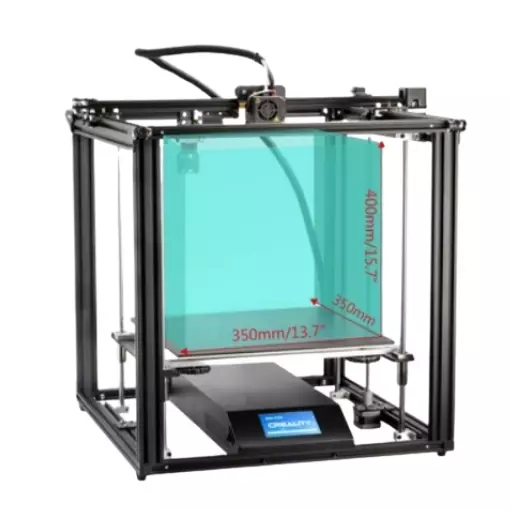Compare Ender 5 Plus vs K1 Max
Comparison between the best 3D printers
Choose the best 3D printer at the best price. The cheapest 3D printers are here.
Buy a 3D printer here with 3D Fila.
 |
 |
|
| Model | Ender 5 Plus[BUY Ender 5 Plus] |
K1 Max[BUY K1 Max] |
| Printing Material | Filament | Filament |
| Buy Filament for Creality 3D Ender 5 Plus | Buy Filament forCreality 3D K1 Max | |
| Estimated price | $599,00 | $1300,00 |
| Manufacturer | Creality 3D | Creality 3D |
| Release Year | 2019 | 2023 |
| Print Volume [mm] | 350x350x400 | 300x300x300 |
| Printer Size [mm] | 632x619x666 | 435x462x526 |
| Weight [kg] | 18,2 | 18 |
| Power Loss Recovery | YES | YES |
| Enclosed printer | NO | YES |
| Bed Leveling | Automatic | Automatic |
| Filament End Sensor | YES | YES |
| Bed type | Heated | Heated |
| Power supply system | Bowden | Direct Drive |
| Standard nozzle | 0,4 | 0,4 |
| Maximum Nozzle Temperature [°C] | 260 | 300 |
| Maximum Bed Temperature [°C] | 100 | 100 |
| Maximum printing speed [mm/s] | 180 | 600 |
| Filament holder | YES | YES |
| Camera for supervision | NO | NO |
| Recommended filaments | PLA, TPU, ABS, PETG | ABS, PLA, PETG, TPU, PA, ASA, PC, PLA-CF, PA-CF, PET-CF |
| Recommended slicers | Cura, Simplify, Slic3r | Creality Print, Cura, Simplify, Slic3r, IdeaMaker e outros |
| Maximum Resolution [mm] | 0,1 | 0,1 |
| Processor | 32 bits | |
| Display | Touchscreen TFT 4,3'' | Display touchscreen 4,3'' |
| Power Supply | 24V / 504W | |
| Connectivity | SD / USB | USB / Wi-Fi / Ethernet |
| Operating systems | Windows, Mac, Linux | Windows, Mac, Linux |
| Date of registration in the system | 2021-04-14 | 2023-12-01 |
| Release date | 2019 | 2023 |
| Extra features | The Ender 5 Plus offers a large print volume (350x350x400 mm) and fast assembly. It includes a BLTouch sensor, but with range limitations. It stands out for its dimensional accuracy, although it requires adjustments to the slicer settings. Despite the noise, its integrated design saves space, and includes features such as a filament sensor and power resumption. Ideal for large projects, it requires refinement in the settings for high-quality prints. | The Creality K1 Max stands out as a fast Core XY 3D printer with a large build volume of 300 x 300 x 300 mm. It is fully enclosed and equipped with AI sensors to prevent print failures. This model has a smooth and flexible PEI build platform, and uses an automatic leveling system with LIDAR, as well as a filament run-out sensor. LAN, Creality Cloud and USB Flash Disk connectivity are available, as well as a 4.3-inch touchscreen interface. The K1 Max is robust, weighing in at 18 kg, and includes an AI camera and limited version of the Klipper firmware. Its motion system is solid and the printer is efficient with high-temperature filaments, but it is not silent. Assembly is 99% complete, requiring only minor adjustments before use. |
| Support for multiple colors and materials (AMS and CFS) | NO | NO |
Notes * |
||
| Cost-benefit | 6 / 10 | 7 / 10 |
| Hardware | 2 / 10 | 4.8 / 10 |
| Tela | . | . |
| Print volume | 4 / 10 | 4 / 10 |
| Performance | 1 / 10 | 5 / 10 |
| [BUY Ender 5 Plus] | [BUY K1 Max] |
Conclusion |
| In comparing the Ender 5 Plus and the K1 Max 3D printers, several key differences stand out that cater to distinct user needs and preferences. The **Ender 5 Plus**, released in 2019, offers a larger print volume, making it ideal for larger projects. It has a more budget-friendly price point, which may appeal to hobbyists or those new to 3D printing. Despite this, it requires some manual adjustments for optimal print quality, making it less user-friendly for beginners compared to newer models. Furthermore, its open-frame design may pose issues with temperature management, especially when working with certain filaments. On the other hand, the **K1 Max**, a newer model released in 2023, comes fully enclosed, providing better thermal stability and allowing for advanced printing with high-temperature materials. This printer features modern touches such as AI sensors for preventing print failures and advanced connectivity options, including Wi-Fi and Ethernet, enhancing its usability and integration into a smart workflow. The automatic leveling system and high-speed capabilities significantly boost performance, appealing to users looking for efficiency and precision in their printing tasks. While the Ender 5 Plus scores lower in cost-benefit and hardware metrics, the K1 Max outperforms in performance and overall user experience. For those prioritizing budget and basic functionality, the Ender 5 Plus provides a solid entry into the world of 3D printing. However, for users willing to invest a bit more for advanced features, enhanced performance, and the ability to work with a wider range of materials, the K1 Max is the clear winner. Ultimately, the choice depends on the user's specific needs—whether it be cost efficiency or high-end capabilities. |

